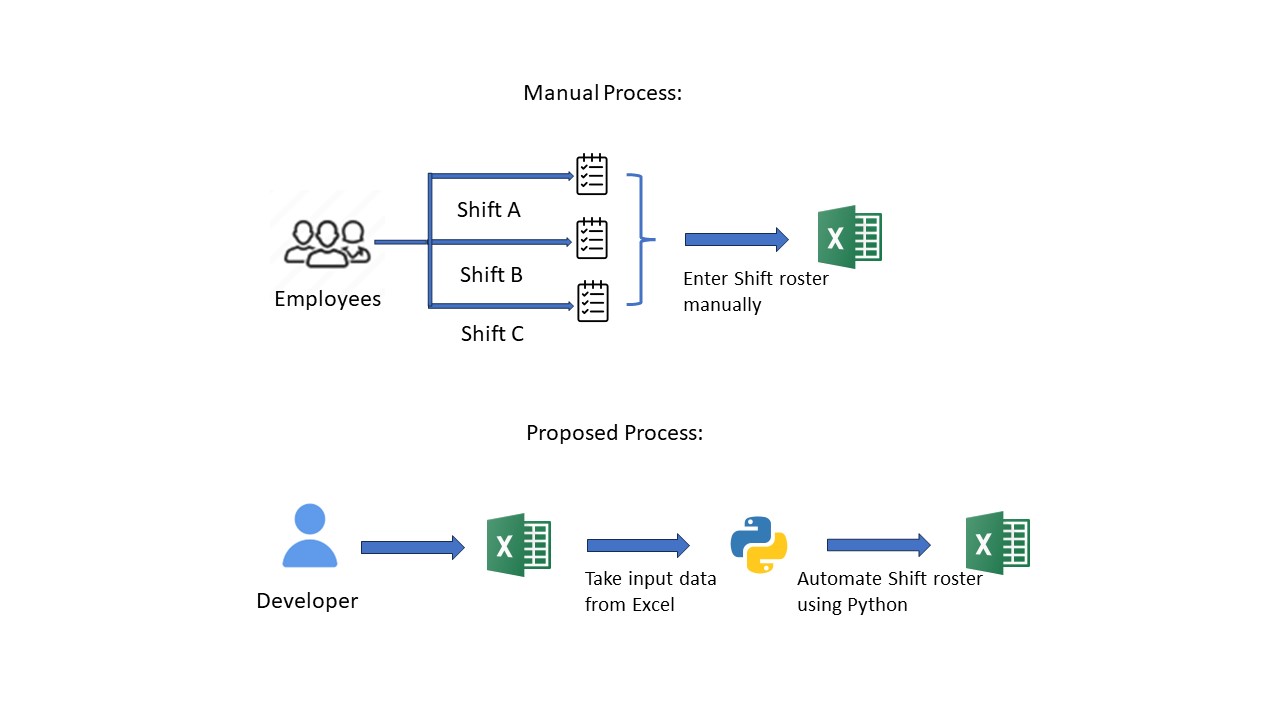Purpose of the article: To guide the reader through the process of automating shift roster using Python.
Intended Audience: This POC/Blog will be helpful for Managers/Supervisors, Human Resources(HR) Professionals, Employees, Schedulers/Planners.
Tools and Technology: Python and PyCharm
Keywords: Python, Excel data and PyCharm
Introduction:
- Managing shift rosters manually can be a time-consuming and error-prone task.
- It often involves juggling multiple spreadsheets, coordinating with employees, and ensuring optimal coverage.
- However, thanks to the power of automation and programming languages, such as Python, the process can be simplified and made more efficient. This blog will explore how Python can automate shift roster management, saving time, reducing errors, and improving overall productivity.
Project Architecture/Flow:

Collecting and Organizing Data:
- The first step in shift roster automation is gathering and organizing the necessary data, including employee information, shift preferences, availability, and other relevant details.
- Python provides various libraries, such as Pandas, which allow you to read, manipulate, and structure data from multiple sources, such as spreadsheets or databases.
- By leveraging these libraries, you can easily import and store the required information for roster management.
Generating Shift Schedules:
- Once the data is organized, Python can help generate shift schedules automatically.
- You can use algorithms and logic to assign shifts based on predefined rules, employee availability, and preferences.
- Python’s flexibility enables you to implement complex scheduling algorithms tailored to your organization’s requirements.
- Automating this process can reduce the risk of errors and ensure fair and efficient shift distribution.
How to Automate Shift Roster Using Python:
Step 1: Importing Libraries
- The code begins by importing essential Python libraries: ‘pandas’ for data manipulation, ‘datetime’ for date handling, ‘schedule’ for task scheduling, and ‘time’ for managing time-related functions.

Step 2: ‘get_next_dates’ Function
- This function generates a list of future dates and their corresponding weekdays, taking a starting date and the number of dates needed as input, producing a list of date-weekday pairs.

Step 3: Get Input Data from Excel


Step 4: Design_Shift_Roaster Function
- Data Loading: Loads data from an Excel file named ‘ShiftRoaster.xlsx.
- Date Calculation: Calculates the dates for the next 14 days to be used as new columns in the Excel sheet.
- Shift Rules: Defines different shift rules for different employee groups.
- Roster Creation: Processes the rows from ‘Sheet2’ according to the defined shift rules and creates a new roster. The new roster is constructed with additional columns for the next 14 days.
- Data Writing: Writes the resulting roster to a new sheet named ‘NewSheet’ within the same Excel file.

Step 5: Scheduling
- The code attempts to schedule the execution of the ‘design_shift_roaster’ function every 14 days using the ‘schedule` library.
- A `job` function is defined to execute the roster design, set to run every 14 days.
- The scheduling loop ensures that the job keeps running to maintain the roster.

Step 6: Error Handling
- A basic error-handling block is included in the code, but it can be improved for better error reporting.
- The modified block prints informative error messages when an error occurs, allowing for easier troubleshooting.

Step 7: Update the Output to a New Sheet in the Same Excel File.

Conclusion:
Automating shift roster management using Python offers numerous benefits, including increased productivity, reduced errors, and improved employee satisfaction. By leveraging Python’s data manipulation, scheduling algorithms, and communication capabilities, you can streamline the entire shift roster process, saving time and resources for your organization. Whether you are a small business or a large enterprise, embracing automation with Python can revolutionize your shift management practices and empower your workforce.
Author Bio:

Vijay Kumar D
Associate software engineer- Data Science-Analytics
An energetic, flexible, hardworking, and motivated person with a passion for innovation. Having 2.11 years of experience in CHEP US automation project. Having Knowledge in Python, AWS, Azure, Flask, ML and MySQL.


